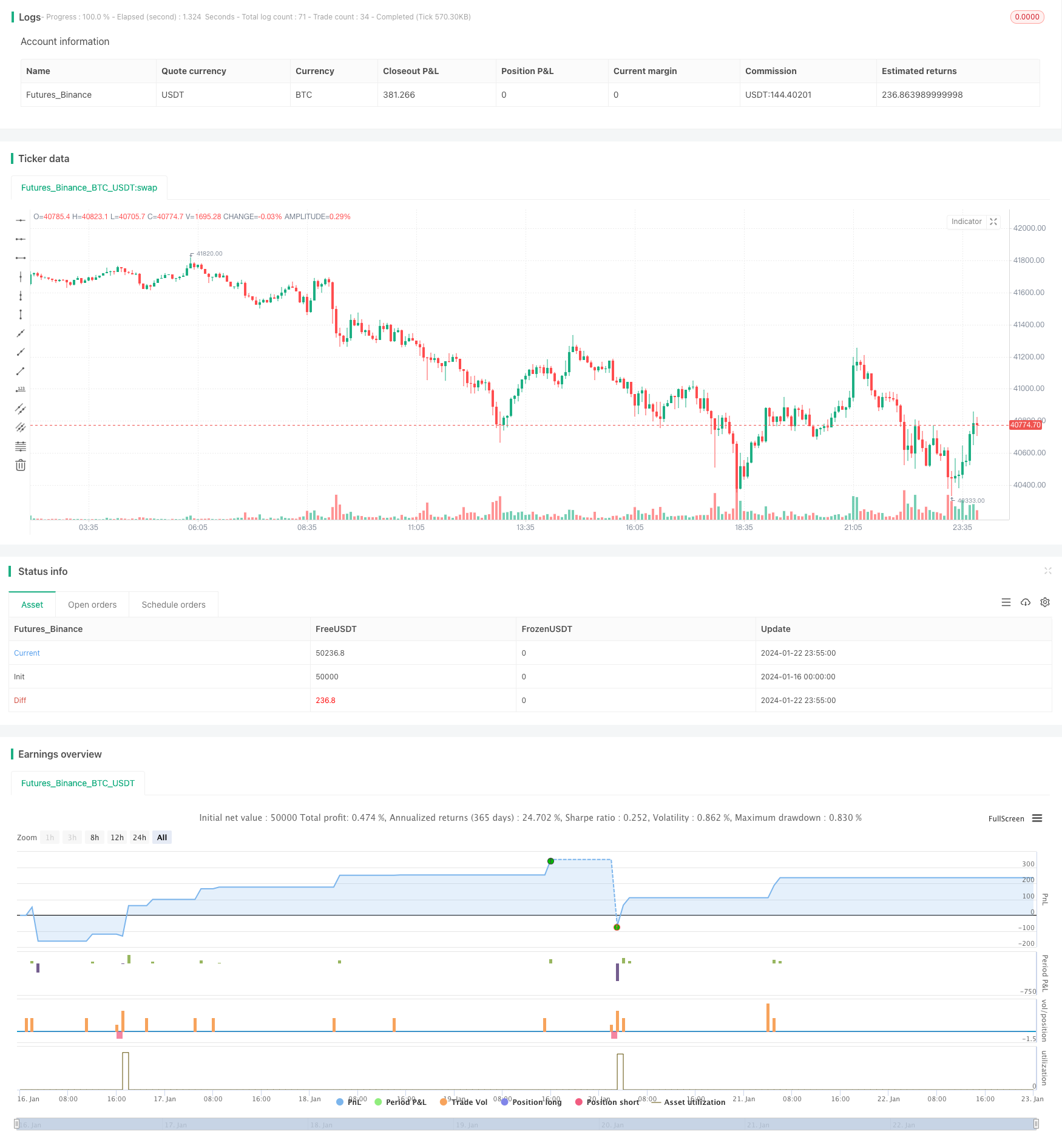RSI e estratégia de ruptura da média móvel
Autora:ChaoZhang, Data: 2024-01-24 14:31:01Tags:

Resumo
A estratégia de ruptura do RSI e da média móvel é uma estratégia quantitativa que utiliza tanto o indicador do RSI quanto as linhas médias móveis para determinar oportunidades de negociação.
Estratégia lógica
-
Calcular o indicador RSI e as linhas da média móvel simples com base em parâmetros definidos pelo utilizador.
-
Quando o RSI cruza acima da linha de sobrevenda (default 30), um sinal longo é gerado se o preço estiver abaixo da média móvel de saída LONG.
-
Quando o RSI cruza abaixo da linha de sobrecompra (default 70), um sinal curto é gerado se o preço estiver acima da média móvel de saída curta.
-
Os usuários podem escolher filtrar sinais com base em uma linha de média móvel de tendência.
-
As saídas são determinadas pelas linhas de saída LONG e SHORT Moving Average.
Análise das vantagens
-
A concepção de indicadores duplos melhora a precisão ao incorporar dois factores de mercado importantes.
-
Utiliza a característica de reversão média do RSI de forma eficaz para localizar pontos de virada.
-
Filtro adicional com médias móveis aumenta o rigor lógico para evitar perseguir tops e bottoms.
-
Parâmetros personalizáveis permitem otimizações em diferentes produtos e prazos.
-
A lógica simples torna-a fácil de compreender e modificar.
Análise de riscos
-
Os whipssaws são comuns com RSI, o indicador de densidade pode ajudar.
-
O RSI tende a falhar em prazos mais longos, os parâmetros podem ser ajustados ou indicadores adicionais podem ajudar.
-
As médias móveis têm um efeito de atraso, os comprimentos podem ser encurtados ou indicadores como o MACD podem ajudar.
-
Devem ser introduzidos mais indicadores para validar os sinais devido à lógica básica.
Orientações de otimização
-
Otimizar os parâmetros do RSI ou introduzir um indicador de densidade para reduzir os falsos sinais.
-
Incorporar indicadores de tendência e volatilidade como DMI e BOLL para localizar tendências e suporte.
-
Introduzir o MACD para substituir ou complementar os julgamentos da média móvel.
-
Adicionar mais condições lógicas em sinais de entrada para evitar fugas desfavoráveis.
Conclusão
A estratégia combina a detecção de sobrecompra e sobrevenda de RSI e determinação de tendência de médias móveis para capitalizar as oportunidades de reversão da média teoricamente. A estratégia é intuitiva e fácil de usar para iniciantes, e pode ser otimizada em diferentes produtos, tornando-se uma estratégia quantitativa inicial recomendada.
/*backtest
start: 2024-01-16 00:00:00
end: 2024-01-23 00:00:00
period: 5m
basePeriod: 1m
exchanges: [{"eid":"Futures_Binance","currency":"BTC_USDT"}]
*/
//Global Market Signals: RSI Strategy.
//@version=4
strategy("GMS: RSI Strategy", overlay=true)
LongShort = input(title="Long Only or Short Only or Both?", type=input.string, defval="Both", options=["Both", "Long Only", "Short Only"])
RSILength = input(title="RSI Length", type = input.integer ,defval=14)
RSIUpper = input(title="Upper Threshold", type = input.float ,defval=70)
RSILower = input(title="Lower Threshold", type = input.float ,defval=30)
LongExit = input(title="Long Exit SMA Length", type = input.integer ,defval=5)
ShortExit = input(title="Short Exit SMA Length", type = input.integer ,defval=5)
AboveBelow = input(title="Trend SMA Filter?", type=input.string, defval="Above", options=["Above", "Below", "Don't Include"])
TrendLength = input(title="Trend SMA Length", type = input.integer ,defval=200)
//Long Side
if LongShort =="Long Only" and AboveBelow == "Above"
strategy.entry("LONG", true, when = rsi(close,RSILength)<RSILower and close< sma(close,LongExit) and close>sma(close,TrendLength))
strategy.close("LONG", when = close>sma(close,LongExit))
if LongShort =="Long Only" and AboveBelow == "Below"
strategy.entry("LONG", true, when = rsi(close,RSILength)<RSILower and close< sma(close,LongExit) and close<sma(close,TrendLength))
strategy.close("LONG", when = close>sma(close,LongExit))
if LongShort =="Long Only" and AboveBelow == "Don't Include"
strategy.entry("LONG", true, when = rsi(close,RSILength)<RSILower and close< sma(close,LongExit))
strategy.close("LONG", when = close>sma(close,LongExit))
if LongShort =="Both" and AboveBelow == "Above"
strategy.entry("LONG", true, when = rsi(close,RSILength)<RSILower and close< sma(close,LongExit) and close>sma(close,TrendLength))
strategy.close("LONG", when = close>sma(close,LongExit))
if LongShort =="Both" and AboveBelow == "Below"
strategy.entry("LONG", true, when = rsi(close,RSILength)<RSILower and close< sma(close,LongExit) and close<sma(close,TrendLength))
strategy.close("LONG", when = close>sma(close,LongExit))
if LongShort =="Both" and AboveBelow == "Don't Include"
strategy.entry("LONG", true, when = rsi(close,RSILength)<RSILower and close< sma(close,LongExit))
strategy.close("LONG", when = close>sma(close,LongExit))
//SHORT SIDE
if LongShort =="Short Only" and AboveBelow == "Above"
strategy.entry("SHORT", false, when = rsi(close,RSILength)>RSIUpper and close> sma(close,ShortExit) and close>sma(close,TrendLength))
strategy.close("SHORT", when = close<sma(close,ShortExit))
if LongShort =="Short Only" and AboveBelow == "Below"
strategy.entry("SHORT", false, when = rsi(close,RSILength)>RSIUpper and close> sma(close,ShortExit) and close<sma(close,TrendLength))
strategy.close("SHORT", when = close<sma(close,ShortExit))
if LongShort =="Short Only" and AboveBelow == "Don't Include"
strategy.entry("SHORT", false, when = rsi(close,RSILength)>RSIUpper and close> sma(close,ShortExit))
strategy.close("SHORT", when = close<sma(close,ShortExit))
if LongShort =="Both" and AboveBelow == "Above"
strategy.entry("SHORT", false, when = rsi(close,RSILength)>RSIUpper and close> sma(close,ShortExit) and close>sma(close,TrendLength))
strategy.close("SHORT", when = close<sma(close,ShortExit))
if LongShort =="Both" and AboveBelow == "Below"
strategy.entry("SHORT", false, when = rsi(close,RSILength)>RSIUpper and close> sma(close,ShortExit) and close<sma(close,TrendLength))
strategy.close("SHORT", when = close<sma(close,ShortExit))
if LongShort =="Both" and AboveBelow == "Don't Include"
strategy.entry("SHORT", false, when = rsi(close,RSILength)>RSIUpper and close> sma(close,ShortExit))
strategy.close("SHORT", when = close<sma(close,ShortExit))
- Estratégia de negociação cruzada de média móvel dupla
- RSI combinado com bandas de Bollinger e estratégia quantitativa de suporte/resistência dinâmica
- Estratégia dinâmica de suspensão da EMA dupla
- Estratégia de negociação quantitativa combinada com vários indicadores
- Contrarian Donchian Channel Touch Entry Strategy com pausa de perda pós-stop e perda de stop de tração
- Combo de estratégia de negociação de curto prazo de indicador de vela única intradiária
- Estratégia de negociação cruzada de média móvel
- RSI Bollinger Bands Estratégia de negociação
- Tendência de seguir uma estratégia baseada na dupla EMA
- Estratégia de ruptura de média móvel dupla
- Estratégia de acompanhamento da EMA
- Tendência de seguir uma estratégia baseada na média móvel
- SMA Crossover Ichimoku Estratégia de negociação quantitativa baseada em volume de profundidade de mercado
- Estratégia de rastreamento de tendências
- Estratégia de ensaio posterior do indicador Qstick de cruzamento bidirecional do eixo zero
- Estratégia de negociação cruzada de média móvel
- Estratégia de divergência da média móvel
- Estratégia de negociação de alta frequência de inversão baseada na linha sombra
- Estratégia de negociação quantitativa baseada no RSI de regressão linear
- Esta estratégia é uma estratégia bidirecional de rastreamento de impulso de filtragem de intervalo adaptativo